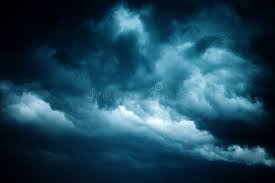

White and/or grey patchy, sheet, or layered clouds generally composed of laminae (plates), rounded masses, or rolls. They may be partly fibrous or diffuse and may or may not be merged. Most of these regularly arranged small elements have an apparent width of one to five degrees (larger than the little finger and smaller than three fingers held at arm's length). When the edge or a thin semi-transparent patch of altocumulus passes in front of the sun or moon, a corona appears. This coloured ring has red on the outside and blue inside and occurs within a few degrees of the sun or moon. The most common mid-level cloud, multiple layers of altocumulus often appear at different levels at the same time. Many times, altocumulus will appear with other cloud types.
Gray or bluish cloud sheets or layers of striated or fibrous clouds that totally or partially cover the sky. They are thin enough to regularly reveal the sun as if seen through ground glass. Altostratus clouds do not produce a halo phenomenon nor are the shadows of objects on the ground visible. Sometimes virga (streaks of rain) is seen hanging from altostratus and at times may even reach the ground, causing very light precipitation.
Resulting from thickening altostratus, this is a dark grey cloud layer diffused by falling rain or snow. It is thick enough throughout to blot out the sun. Low, ragged clouds frequently occur beneath this cloud and sometimes merge with its base. The cloud base lowers as precipitation continues. Because of the lowering base, it is often erroneously called a low-level cloud. Both altostratus and nimbostratus can extend into the high level of clouds.
